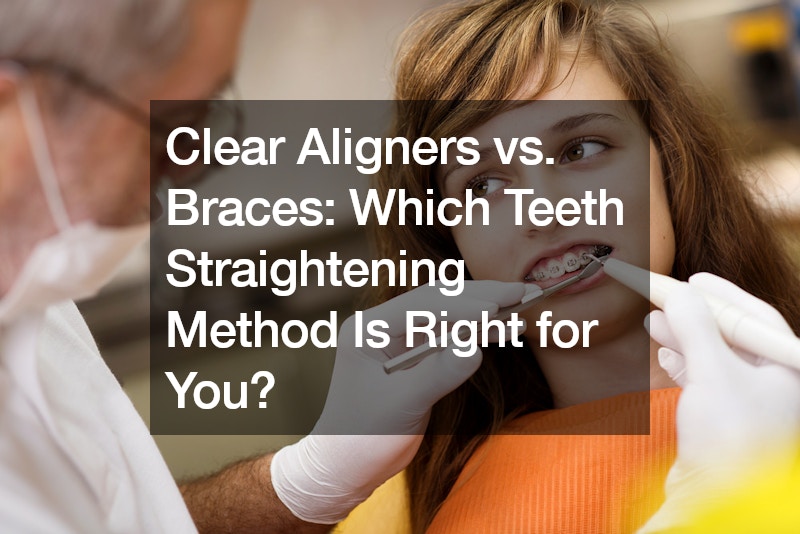Choosing the right method to straighten your teeth can be a daunting task. With so many options available, it’s essential to understand the benefits and drawbacks of each. Two of the most popular choices are clear aligners and traditional braces. This article will explore these methods in detail to help you decide which one is right for you.
Clear Aligners
Clear aligners, such as Invisalign, are a modern solution for straightening teeth. These are plastic trays that fit over your teeth and gradually move them into the desired position.
Many people prefer clear aligners because they are nearly invisible, making them an excellent choice for those who are concerned about the appearance of their smile during treatment.
Benefits of Clear Aligners
Aesthetic Appeal: One of the most significant advantages of clear aligners is that they are almost invisible. This is a major selling point for adults and teenagers who want to straighten their teeth without the noticeable appearance of metal braces.
Comfort: Clear aligners are made of smooth plastic, which is less likely to irritate your gums and cheeks compared to metal braces.
Removable: You can take clear aligners out when eating, drinking, brushing, and flossing. This makes maintaining oral hygiene easier than with braces.
Fewer Office Visits: Typically, clear aligners require fewer visits to the orthodontist, as you can change to the next set of aligners at home.
Drawbacks of Clear Aligners
Compliance: For clear aligners to be effective, you need to wear them for 22-23 hours a day. Forgetting to wear them or not wearing them consistently can significantly extend your treatment time.
Cost: Clear aligners can be more expensive than traditional braces, depending on your treatment plan and location.
Not Suitable for All Cases: Clear aligners are best for mild to moderate dental issues. Severe cases of misalignment or complex dental problems may still require traditional braces.
Traditional Braces
Traditional braces are the most common method for straightening teeth. They consist of metal brackets that are glued to your teeth and connected by wires and rubber bands. Over time, the wires are adjusted to move your teeth into the desired position.
Benefits of Traditional Braces
Effectiveness: Braces are highly effective for all types of dental issues, from minor adjustments to complex cases. They provide precise control over the movement of your teeth.
No Compliance Issues: Unlike clear aligners, you can’t take braces off, which means you don’t have to worry about forgetting to wear them.
Cost: Traditional metal braces are generally more affordable than clear aligners and other types of braces.
Drawbacks of Traditional Braces
Aesthetic Concerns: Braces are very noticeable, which can be a concern for many people, especially adults.
Discomfort: The metal brackets and wires can irritate your gums and cheeks. Regular adjustments can also cause discomfort.
Oral Hygiene Challenges: Braces can make brushing and flossing more difficult, increasing the risk of tooth decay and gum disease.
Ceramic Braces
Ceramic braces are similar to traditional metal braces but use clear or tooth-colored brackets. They offer a less noticeable alternative while providing the same effectiveness.
Benefits of Ceramic Braces
Less Noticeable: Ceramic braces blend in with your teeth, making them less visible than metal braces.
Effective: They provide the same precise control over teeth movement as metal braces.
Drawbacks of Ceramic Braces
Cost: Ceramic braces are usually more expensive than metal braces.
Discoloration: The clear brackets can stain if not properly cared for, which can affect their aesthetic appeal.
Lingual Braces
Lingual braces are another option for those who want a discreet way to straighten their teeth. These braces are attached to the back of your teeth, making them invisible from the front.
Benefits of Lingual Braces
Invisible: Lingual braces are hidden behind your teeth, making them completely invisible from the front.
Effective: They are as effective as traditional braces for complex dental issues.
Drawbacks of Lingual Braces
Cost: Lingual braces are often the most expensive option.
Discomfort: They can be uncomfortable at first and may affect your speech temporarily.
Hygiene: Cleaning around lingual braces can be more challenging.
Consultation Tips
Before deciding on a treatment method, it’s crucial to have a consultation with your dentist or orthodontist. They will assess your dental needs and help you choose the best option. Here are some things to consider:
Aesthetics: How important is it to you that your braces are not visible? Clear aligners and lingual braces offer more discreet options.
Compliance: Are you disciplined enough to wear clear aligners for 22-23 hours a day? If not, traditional braces might be a better choice.
Budget: How much are you willing to spend on teeth straightening? Traditional braces are typically the most affordable, while lingual braces can be the most expensive.
Finances
Finances are an essential factor to consider. Costs can vary based on the treatment type and your location. Generally, lingual braces are the most expensive, followed by clear aligners and ceramic braces, with traditional metal braces being the most affordable.
Recap
In conclusion, whether you choose clear aligners like Invisalign or traditional braces depends on your individual needs and preferences. Clear aligners offer a discreet and comfortable option, but they require strict compliance. Traditional braces are highly effective for all dental issues but are more noticeable. Ceramic and lingual braces provide alternatives with their own sets of benefits and drawbacks.
Consult with your dental provider to determine the best option for you. Remember, the goal is to achieve a beautiful, healthy smile that you can be proud of. Good luck with your teeth straightening journey!
.


